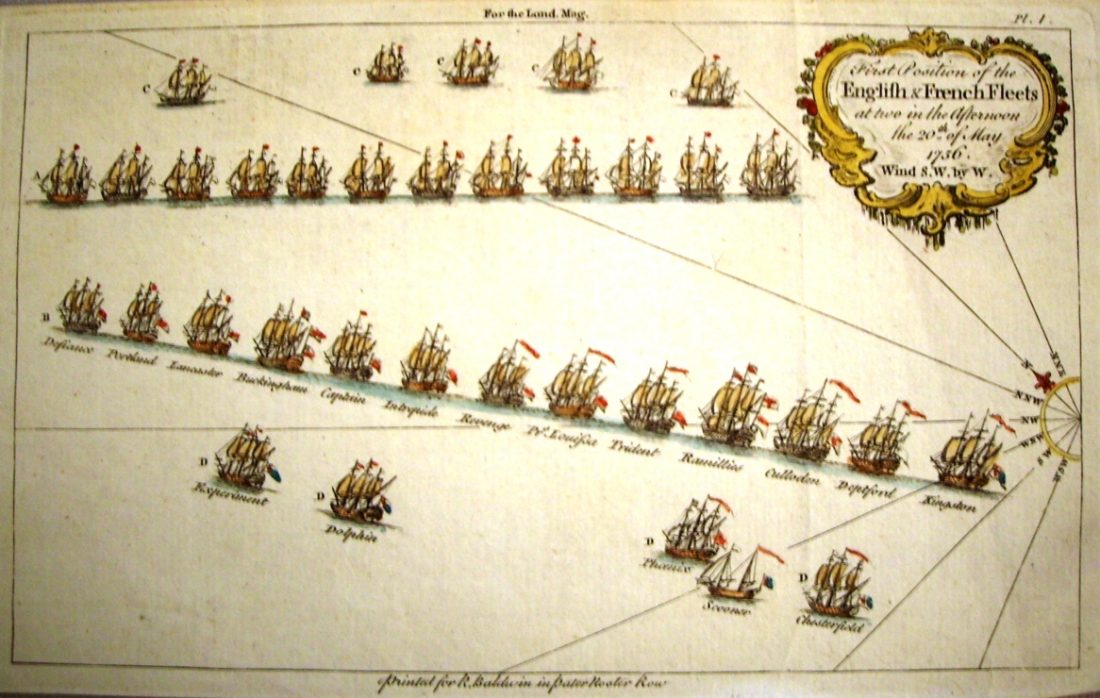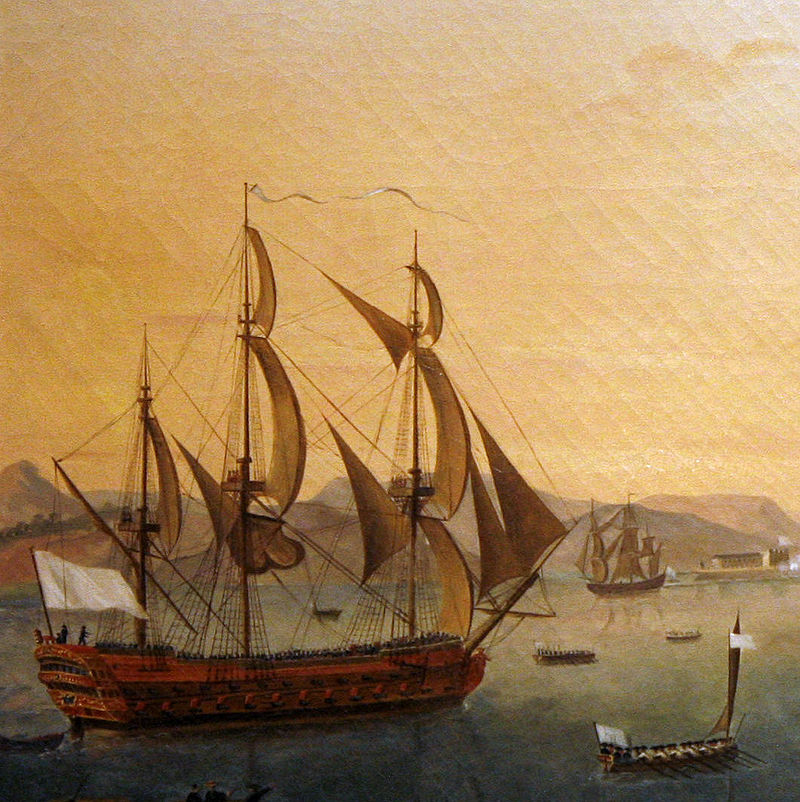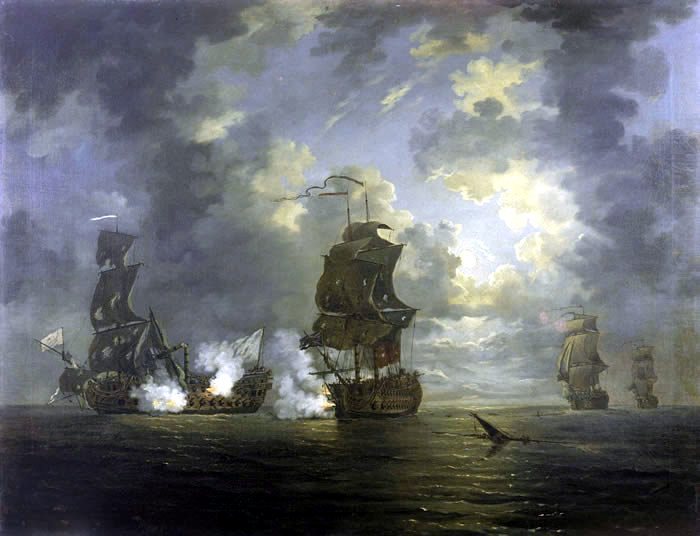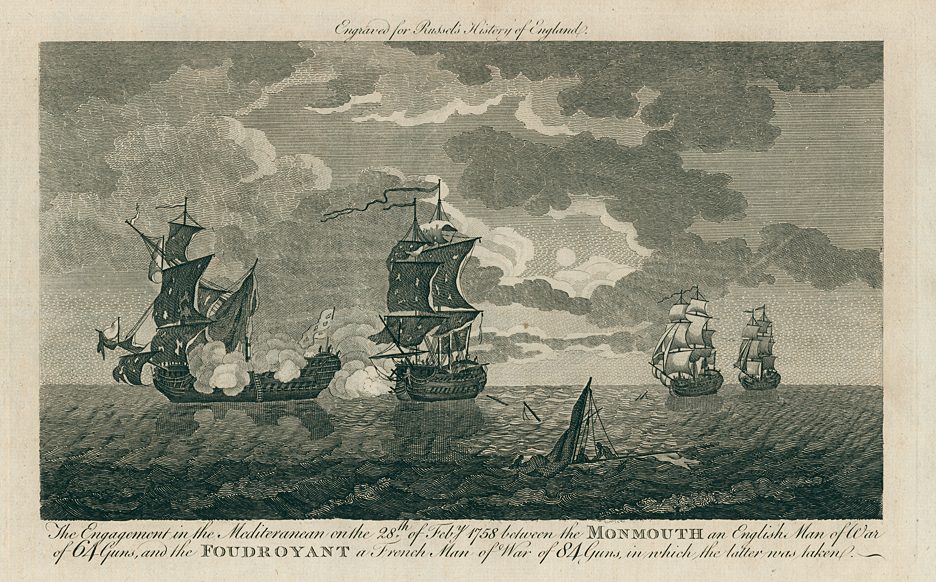Unequal Duel, 1758: HMS Monmouth vs. Foudroyant

Admiral Byng
The execution by firing squad in 1757 of Admiral John Byng (1704-1757) on the quarterdeck of HMS Monarch in 1757 is perhaps best remembered by Voltaire’s verdict in his novel Candide: “In this country, it is good to kill an admiral from time to time, in order to encourage the others.” Byng had been court-martialled for failure to relieve the besieged British garrison in Minorca in the Western Mediterranean the previous year.
The key element in the charge was that Byng“had not done his utmost against the enemy in battle or pursuit”, as required by the “Articles of War” that governed the Royal Navy. A death sentence was mandatory for conviction on this charge. Byng’s squadron was seriously undermanned and ill-prepared for the latest conflict with France – later to be known as the Seven Years War. One of the French opening moves was to land 15,000 men on Minorca and lay siege to the British base there. Byng’s force, sent to succour the besieged garrison, did indeed engage the enemy in the inconclusive naval Battle of Minorca in May 1756 and, following a council with his senior officers thereafter, he decided that Minorca was beyond saving from the French. Byng brought his ships back to Gibraltar for refitting and the Minorca garrison was obliged to surrender to the French, thereby depriving Britain of a vital strategic resource. Recalled to Britain, Byng’s disgrace, court-martial and execution followed.
 Contemporary diagram of the Battle of Minorca, 1756
Contemporary diagram of the Battle of Minorca, 1756
Though the full responsibility for the disaster had been laid on Byng, a degree of opprobrium also attached itself to his captains. Among these was Captain Arthur Gardiner, who had been Byng’s flag-captain, an honourable man who felt that his own honour had been compromised. He appears to have been especially hurt by a remark by the First Lord of the Admiralty, the formidable Lord Anson, which he reported to his friends and was to the effect that “he was one of the men who had brought disgrace on the nation.” For a man like Gardiner, it was essential to demonstrate, at whatever cost to himself, that he was not the man Anson had judged him to be.
Soon after Byng’s death, Gardiner was sent back to the Mediterranean in command of the 64-gun HMS Monmouth, as part of Admiral Henry Osborne’s squadron. Classed as a “Third rate”, HMS Monmouth was a veteran, ninety-0ne years old. She had been built in Chatham in 1666 and had been present in the dockyard there at the time of the great DutchAdmiral Michiel de Ruyter’s spectacular raid in 1667. Finally scrapped in 1767, her century’s service saw her virtually rebuilt three times and she earned seven major battle honours.
In early 1758 Admiral Osborne’s force had succeeded in driving a French fleet of fifteen ships into the Spanish port of Cartagena and keeping them blockaded there. This fleet had been en-route to Louisbourg, the great French fortress on Cape Breton Island, with reinforcements. On February 28th a French relieving force of three ships-of-the-line, carrying the Governor of “New France” (French Canada) and under the naval command of Admiral Gallifoniere. This officer also spotted the British force and, realising that it was larger, decided to retreat. Osborne responded by ordering a general chase, directing Gardiner in HMS Monmouth, and two other ships, the Hampton Court and the Swiftsure, to engage Gallifoniere’s flagship, the Foudroyant. The latter was one of the most powerful vessels afloat, her eighty guns consisting of thirty 42-pounders – enormous weapons for the time – as well as thirty-two 24-pounders and eighteen 12-pounders. With a crew of 470, a French privateer previously captured by HMS Monmouth had said of the Foudroyant that “She would fight today, tomorrow, and the next day, but could never be taken.” By contrast, HMS Monmouth was armed with sixty-four 24-pounders and had a crew of 470 and her two consorts were almost identically armed. Together, these three ships might have been enough to defeat the more powerful French vessel, but any one of them alone would be heavily outgunned.
 A French “64” of the period – Monmouth would have looked generally similar
A French “64” of the period – Monmouth would have looked generally similar
(Attribution: Wikipedia Commons and www.musee-marine.fr Authority control VIAF: 19144648200974718522 Museofile: M5026 Accession number 3 OA 10)
An accident of fate had provided Gardiner with the opportunity he craved to wipe out the stain on his honour. As HMS Monmouth, faster-sailing than Hampton Court or Swiftsure, closed with Foudroyant it was revealed that she was flying the flag of the Admiral Gallifoniere, the commander who had been present on board her during the action with Byng. Eager now for action, Gardiner pressed on with HMS Monmouth, determined to engage the Foudroyant at any cost and unwilling to wait for the other British ships to catch up. According to one account he pointed to Foudroyant and told an army-officer on board “Whatever becomes of you and me, that ship must go into Gibraltar.”
By the time HMS Monmouth opened fire on Foudroyant, both Hampton Court and Swiftsure were out of sight and Gardiner was committed to a one-to-one duel. He was wounded in the arm almost immediately, but not badly enough to incapacitate him. Monmouth’s opening fire damaged the Foudroyant’s rigging, thereby lessening her manoeuvrability, and Gardiner placed his ship off the enemy’s quarter. From this position, Monmouth pounded Foudroyant for almost two hours while being exposed to less fire herself (As so often when learning of such actions, one Is struck by the duration of such cannonades – one can only assume that sheer exhaustion of the gun crews would have lessened the rate of fire considerably). Gardiner, directing operations from the open deck, now received his second, and ultimately fatal, wound, a blow from a ball or fragment on his forehead. Before he passed out and was carried below to the surgeon he called for his first lieutenant – Robert Carkett (approx. 1720 – 1780) – and asked him not to give up the ship or halt the action. Carkett responded by having the colours nailed to the mast and with a pistol in each hand swore that he would shoot anybody who would attempt to strike them.
 The climax of the battle, near midnight – the crippled Foudroyant on the left,
The climax of the battle, near midnight – the crippled Foudroyant on the left,
under fire from HMS Monmouth, and Swiftsure and Hampton Court arriving on the right
Painting by Thomas Swaine (1725-1782) – with thanks to Wikipedia
Monmouth’s mizzen mast now collapsed but shortly afterwards the corresponding mast on Foudroyant also came down, followed soon afterwards by her mainmast. Now crippled, the French ship was subjected to no less than four hours of fire from Monmouth, which still had some ability to manoeuvre. This lasted through the evening and into darkness and when Swiftsure arrived on the scene around midnight, to add her fire to Monmouth’s, Foudroyant surrendered. Consistent with the chivalry of the period, the French captain recognised Carketet’s courage by insisting on handing his sword to him, rather than to the more senior officer commanding Swiftsure.
 An engraving of Swaine’s picture. Such engravings were very popular
An engraving of Swaine’s picture. Such engravings were very popular
and some can still be found in English country pubs
Captain Gardiner died the following day but his aspiration to have Foudroyant brought into Gibraltar was realised. Lieutenant Carkett was appointed to command her “as a reward for his conduct and an encouragement for future emulation” and was further rewarded by promotion to post-captain, the coveted goal of every ambitious officer. It was especially valuable as Carkett had originally entered the navy as a common seaman and had risen by his own exertions. This was, however, his last promotion and he was still a captain in 1780 when he was accused – unfairly – of failure to obey signals during the Battle of Martinique. Tragically, he did not live to clear his name as his ship, the Stirling Castle, was wrecked in a hurricane There was only a handful of survivors and Carkett was not among them.
The “butcher’s bill“ for the Monmouth vs. Foudroyant action was decidedly one-sided, reflecting Monmouth’s ability to retain manoeuvrability while her opponent was immobilised. She suffered 27 killed and 79 wounded (a not-inconsiderable loss rate of 23%) while the more powerful Foudroyant had 190 killed and wounded (40%). Gardiner’s grim determination to ignore the disparity in armament had paid off, though it cost him his own life.
It is probable that he found the price an acceptable one for the redemption of his name and honour.
s
 1866: it’s four years since France invaded Mexico and set up a new ‘Mexican Empire’ with a puppet emperor imported from Europe but armies loyal to the republican government still resist. In a land devastated by battles, atrocities and reprisals, the tide of war is now turning in favour of the republic’s ‘Juarista’ supporters. France recognises that the war is unwinnable and evacuation inevitable, but first there will be bitter rearguard actions and old scores to settle.
1866: it’s four years since France invaded Mexico and set up a new ‘Mexican Empire’ with a puppet emperor imported from Europe but armies loyal to the republican government still resist. In a land devastated by battles, atrocities and reprisals, the tide of war is now turning in favour of the republic’s ‘Juarista’ supporters. France recognises that the war is unwinnable and evacuation inevitable, but first there will be bitter rearguard actions and old scores to settle.
Britain is neutral in this conflict, but large British interests – railway and mining enterprises – are at risk as the war-front edges ever closer. Investors in London are demanding British action to protect their assets.
Sub-Lieutenant Nicholas Dawlish is serving on the Pacific Station in the gunvessel HMS Sprightly. She, and her resourceful captain, are tasked with taking ‘appropriate’ action to guarantee the safety of these interests. The situation is complex – not only Juarista, French and Imperial Mexican forces but bandit groups, a volunteer Belgian Legion and ex-Confederate mercenaries are involved. And there’s a powerful ironclad, flying Imperial Mexican colours, commanded by an Austrian aristocrat who’s desperate for glory.
Dawlish is plunged into deadly action by land and sea and, with fluency in French and Spanish, he’ll be his captain’s right-hand man in a web of political intrigue, treachery and greed in which a single mistake can end both their careers.
But for Dawlish there’s something worse, a heart-breaking encounter with a figure from his past to whom he’s linked by a solemn promise that he can’t fulfill. What follows will be torment for his emotions and his conscience . . .
Available in Large Paperback and Kindle formats. Kindle Unlimited subscribers can read at no extra charge. Kindle version available for pre-order. Click the marketplaces below for ordering details:
United States Canada
United Kingdom Australia & New Zealand
Below are the twelve Dawlish Chronicles novels published to date, shown in chronological order. All can be read as “stand-alones”. Click on the covers below for more information. All are available in Paperback or Kindle format and can be read at no extra charge by Kindle Unlimited Subscribers.
Six free short-stories are available for download to your Kindle. Access them by registering for the Dawlish Chronicles mailing list – just click on the banner below. You’ll be kept updated on new books and will receive other free stories at intervals.





